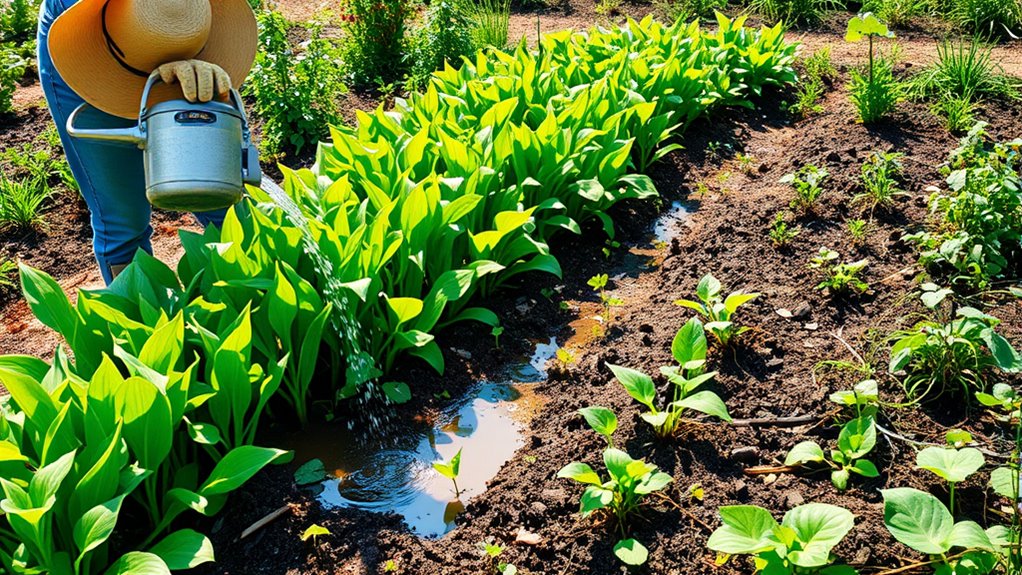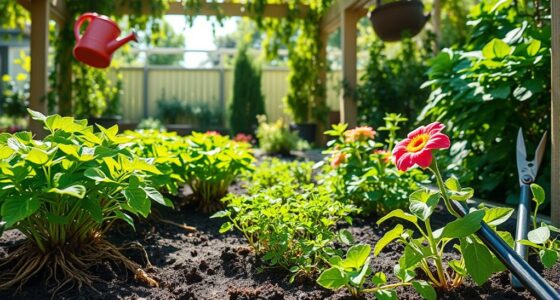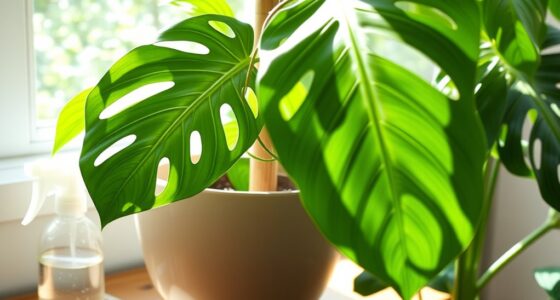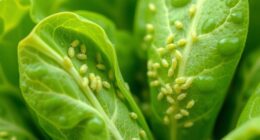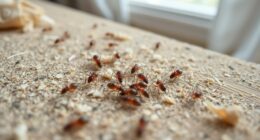To avoid beginner gardening mistakes, start by preparing your soil properly with testing and amendments. Regularly inspect your plants for pests and don’t wait for damage to become severe. Understand each plant’s specific needs for water, light, and space, and avoid overplanting to ensure good airflow and healthy growth. Paying attention early signs of stress or pests can save you trouble later. Keep learning to make your garden thrive—there’s plenty more to discover.
Key Takeaways
- Properly prepare and test soil before planting to ensure optimal pH and nutrient levels.
- Regularly inspect plants for pests and implement natural or proactive pest control methods.
- Research each plant’s specific needs for soil, water, and sunlight to match environmental conditions.
- Avoid overplanting; provide adequate space for airflow, growth, and access to nutrients and light.
- Consistently monitor plant health and adjust care practices based on individual plant requirements.
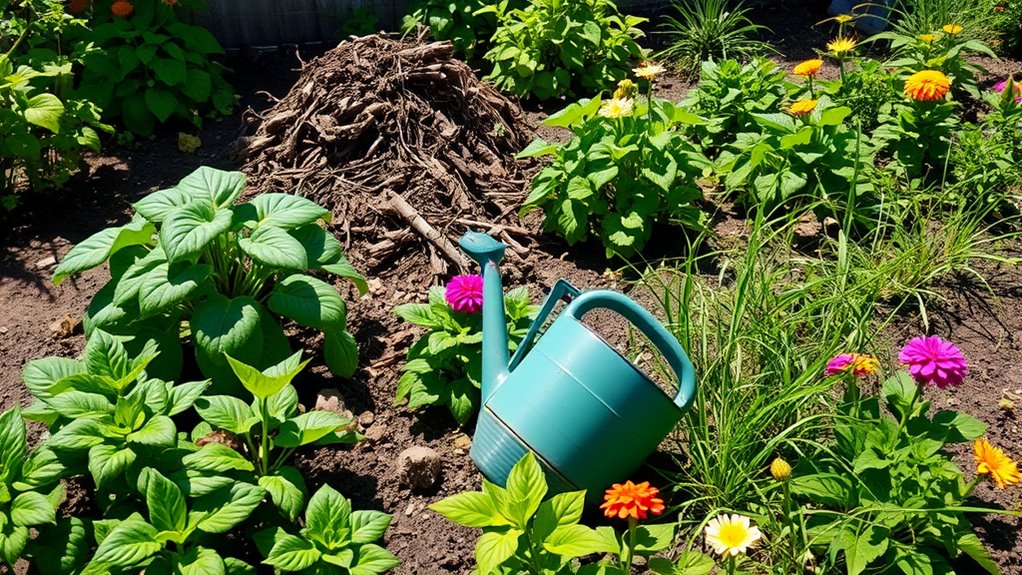
Starting your gardening journey can be exciting, but beginners often make common mistakes that hinder their success. One of the most vital steps you might overlook is proper soil preparation. Healthy soil is the foundation for thriving plants, so it’s essential to invest time in preparing it before planting. You should start by testing your soil’s pH and nutrient levels to understand what amendments it might need. Incorporating compost or organic matter improves soil structure, drainage, and fertility, giving your plants a better chance to grow strong. Avoid the mistake of planting directly into neglected or poor-quality soil, as this can stunt growth and lead to weak plants that are more susceptible to pests and diseases. Proper soil preparation ensures your plants get the nutrients they need and reduces the likelihood of problems later in the season. Using community support features from gardening resources or apps can also provide valuable tips and encouragement throughout your gardening journey.
Proper soil prep boosts plant health and prevents issues later in your gardening journey.
Another common mistake beginners make is neglecting pest management. It’s easy to be caught off guard when pests appear, but proactive pest management is essential for a healthy garden. Instead of waiting until you see damage, take preventative measures. Regularly inspect your plants for signs of pests such as holes in leaves, sticky residue, or discolored foliage. Using natural pest control methods, like introducing beneficial insects, companion planting, or applying organic sprays, can help keep pests at bay without harming your environment. Ignoring pest issues or relying solely on chemical pesticides can cause more harm than good, leading to pesticide-resistant pests and potential health risks. Developing a pest management plan early on will save you frustration and protect your investment in your garden.
Many beginners also underestimate the importance of understanding the specific needs of their plants. Different plants require different soil conditions, watering schedules, and sunlight exposure. Failing to adapt your gardening practices accordingly can result in poor growth or plant failure. Take the time to research the plants you want to grow, paying attention to their soil, water, and light requirements. This knowledge will guide you in making better decisions about soil preparation and pest management, helping you create a more successful garden.
Finally, avoid the mistake of overplanting or planting too densely. Crowded plants struggle with airflow, which can lead to fungal diseases and pest infestations. Give your plants enough space to breathe and grow freely. Proper spacing not only promotes healthy growth but also makes pest management easier by allowing you to spot issues early.
Frequently Asked Questions
How Often Should I Water My Garden Plants?
You should establish a consistent watering schedule to guarantee your plants stay healthy. Typically, water your garden early in the morning or late in the afternoon, providing enough to keep the soil moist but not waterlogged. Keep an eye on plant hydration needs, as different plants require varying amounts of water. Regularly check the soil, and adjust your watering frequency based on weather conditions and soil moisture levels.
What Is the Best Time to Plant Seeds Outdoors?
Timing your outdoor planting is like catching the perfect wave. You should plant seeds after the last frost date, when soil warms and threatens no more frost damage. Keep frost date awareness in mind, and avoid rushing seedling transplantation too early. This guarantees your plants settle in happily, thriving from the start. By waiting for ideal conditions, you give your garden the best chance to flourish and grow strong.
How Do I Prevent Pests Without Chemicals?
To prevent pests without chemicals, you should use natural pest control methods like introducing beneficial insects and encouraging healthy plant growth. Companion planting is also effective; plant herbs like basil or marigolds near your vegetables to repel pests naturally. Regularly inspect your garden for early signs of pests, remove affected plants, and keep your garden tidy. These practices help keep pests at bay while protecting your environment.
Which Soil Type Is Best for Vegetables?
You should choose loamy soil for vegetables, as it offers good drainage and nutrients. To improve your soil, add organic soil amendments like compost or aged manure, which boost fertility. Practice crop rotation each season to prevent soil exhaustion and reduce pests. These steps help create a healthy, balanced environment, ensuring your vegetables grow strong and tasty. Always test your soil first to tailor amendments for peak results.
How Can I Improve Drainage in My Garden?
Great gardening begins with good drainage, so you can prevent water pooling and root rot. Start by adjusting your garden bed layout to improve flow and incorporating composting techniques to enhance soil structure. Mixing organic matter helps water move freely, while elevating beds or adding sand can boost drainage. Regularly check your soil’s moisture, and you’ll create a thriving, well-drained garden that’s healthy and happy.
Conclusion
By avoiding these common gardening mistakes, you’ll set yourself up for a lush, thriving garden. Think of it like planting seeds in rich soil—you need the right care and attention to help everything grow strong. Remember, patience and learning from mistakes are your best tools. With a little effort and awareness, your garden will flourish just like a vibrant, blooming bouquet, turning your outdoor space into a beautiful, peaceful retreat you’ll love.
